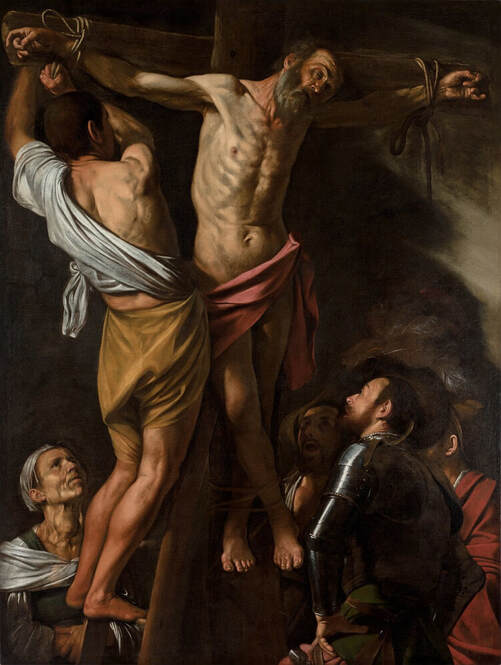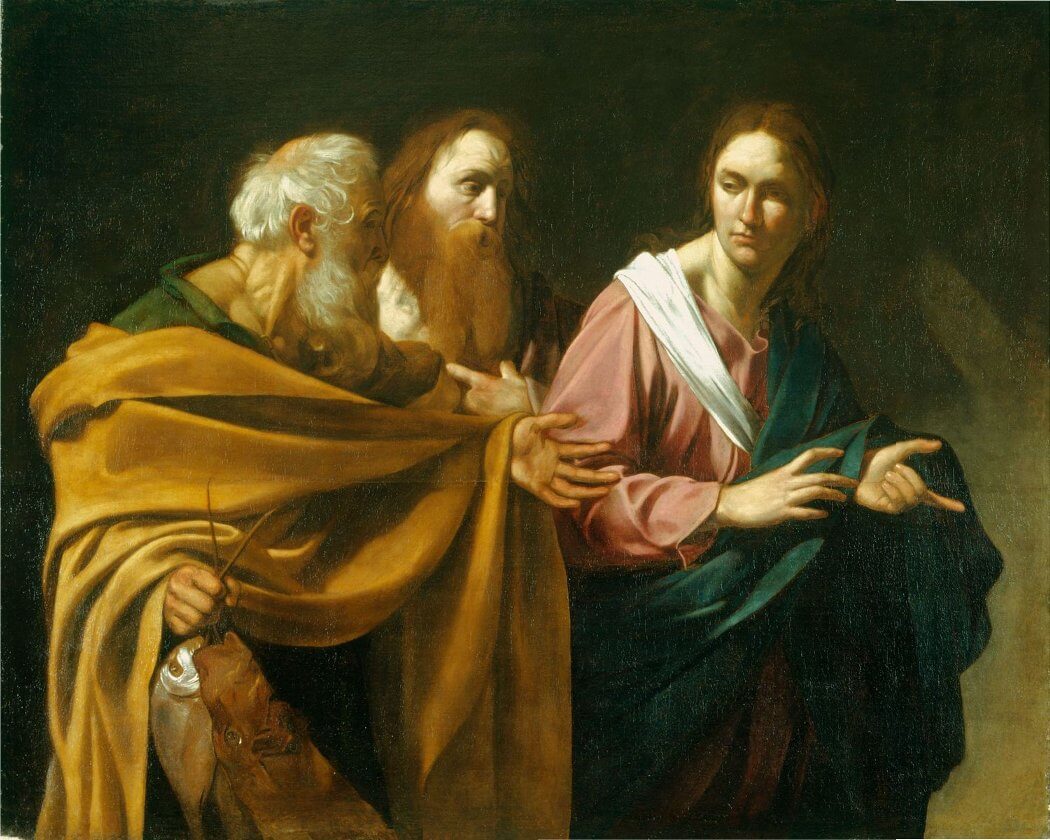|
Where? Gallery 217 of the Cleveland Museum of Art
When? 1606-1607 Commissioned by? Probably Juan Alonso Pimentel de Herrera, the Count of Benavente, Spain, and the ruler of Naples. What do you see? The crucifixion of Saint Andrew. He is tied with ropes to a cross. Saint Andrew has just died, and Caravaggio shows great skill in depicting the moment that Saint Andrew transitions from life to death. You can see in Saint Andrew’s face the combination of a long-suffering and the relief that he can finally die. The executioner on the left stands on a ladder and is about to untighten a rope around the right wrist of Saint Andrew. He wants to take the dead body of the cross. On the bottom right are three other executioners. The man in the foreground, wearing the armor, is the governor of the region where Saint Andrew is crucified. The governor, Aegeas, ordered the crucifixion as Saint Andrew converted his wife to Christianity. He looks in a somewhat arrogant way at what just happened – the way in which Saint Andrew died. Behind him, you can see the open mouth of another executioner who is surprised by the event that just occurred. On the bottom left, a poor woman has her hands folded and seems to be in her thoughts. Backstory: Saint Andrew preached in Greece several years after Jesus had died. After he converted the wife of the governor to Christianity, the governor ordered his crucifixion in the city of Patras. Instead of nailing him on the cross, like what happened to Jesus, they bound Saint Andrew to the cross such that he would suffer longer. According to some legends, Saint Andrew continued to preach from the cross to a large crowd for two straight days. At that time, the crowd demanded his release from the cross, and the governor agreed with this request to prevent riots. However, right at the moment that they wanted to take Saint Andrew of the cross alive, the arms of the executioners froze, and God honored the prayer of Saint Andrew to die on the cross. Who is Saint Andrew? Andrew the Apostle was one of the disciples that was closest to Jesus. After the death of Jesus, he traveled the world to preach the Christian religion. It has been reported that he preached in Greece, Romania, Russia, Turkey, and Ukraine. Saint Andrew is the brother of Saint Peter. They were the first disciples of Jesus, and are mentioned in all four gospels. Between 1603 and 1606, Caravaggio has painted The Calling of Saints Peter and Andrew. This painting is part of the British Royal Collection and on display in the Hampton Court Palace in England. In 1601, Caravaggio also painted the Crucifixion of Saint Peter, which is in the Basilica of Santa Maria del Popolo in Rome.
A real Caravaggio? Caravaggio painted this work while he was in Naples. In 1610, the Spanish ruler of Naples, Juan Alonso Pimentel de Herrera, took the painting with him to Spain. It was in possession of his family until at least 1653, but there is no evidence of the existence of this painting after that. It was lost for over 300 years.
In 1973, it appeared again in the collection of a Spanish art collector, but it took a few years to show that this was a real Caravaggio. The reason is that are at least three high-quality copies of this painting. Comparing the four versions, only the current version displays the superb painting skills of Caravaggio. The Cleveland Museum of Art acquired the painting in 1976. However, as of recently, one of the other three versions is also considered to be a real Caravaggio painting. Saint Andrew’s cross: The most common story about the death of Saint Andrew is that he was crucified on an x-shaped cross. This is called a Saint Andrew’s cross. However, according to one of the earliest sources on the death of Saint Andrew, the Acts of Andrew, he was bound to a normally-shaped (upright) cross. At the time that Caravaggio painted this work, there was still debate about the true shape of Saint Andrew’s cross, and Caravaggio chose for the upright cross. Who is Caravaggio? Michelangelo Merisi da Caravaggio was born in 1573 in Milan and died in 1610 in Porto Ercole, Italy. He is one of the founders of Baroque painting. He was a master in realistically depicting both the physical and mental state of the subjects in his paintings. He was also very innovative in the way he used the contrast between light and dark to emphasize certain aspects in his works. Most of his works are famous nowadays. One example is Bacchus which is in the Uffizi Museum in Florence. Another example is The Musicians in the Metropolitan Museum of Art in New York.
Fun fact: Caravaggio lived a turbulent life, and this is reflected in his art. He had a preference for more cruel topics. For his paintings, he frequently used people he met on the streets as models. These people ranged from prostitutes to criminals, and from con people to sick people. Unlike many other artists, Caravaggio painted them realistically and did not idealize them. As a result, the figures in his paintings have provided quite some inspiration for medical professionals who liked to diagnose some of the diseases that they would recognize in his work.
An example of the diseases found in Caravaggio's models is the woman in the lower left of this painting. She has been diagnosed to suffer from nodular goiter, an enlarged thyroid gland, which leads to a large swelling in the neck. This disease was quite prevalent in Italy, and especially near Naples, at the beginning of the 17th century. The disease still exists today. As an example, both Former U.S. President George H. W. Bush and his wife Barbara have been diagnosed with goiter during their life. Interested in a copy for yourself? Poster or canvas.
Written by Eelco Kappe
References:
0 Comments
Leave a Reply. |
Categories
All
|
- Home
- Blog
-
Museums
- Alte Pinakothek
- Art Institute of Chicago
- Baltimore Museum of Art
- Barber Institute of Fine Arts
- Bargello
- Barnes Foundation
- British Museum
- Church of Sant’Anastasia
- Cleveland Museum of Art
- Courtauld Institute of Art
- Detroit Institute of Arts
- Frans Hals Museum
- Galleria Borghese
- Gallerie dell'Accademia
- Getty Museum
- Guggenheim
- Hermitage Museum
- Kunsthistorisches Museum
- Kunstmuseum Basel
- Legion of Honor Museum
- Louvre
- Mauritshuis
- Metropolitan Museum of Art
- Musee d’Orsay
- Museum of Fine Arts in Boston
- Museum of Modern Art
- National Gallery in London
- National Gallery of Art
- National Museum in Poznań
- Norton Simon Museum
- Ny Carlsberg Glyptotek
- Palace of Versailles
- Palazzo Pitti
- Palazzo Vecchio
- Petit Palais
- Philadelphia Museum of Art
- Prado
- Pushkin Museum
- Ravenna Art Museum
- Rijksmuseum
- San Diego Museum of Art
- Santa Maria delle Grazie
- St. Peter's Basilica
- Städel Museum
- Statens Museum for Kunst
- Tate Britain
- Tate Modern
- Timken Museum of Art
- Uffizi
- Vatican Museums
- Wallace Collection
-
Artists
- Altdorfer
- Anguissola
- Berlin Painter
- Bosch
- Botticelli
- Boucher
- Bronzino
- Bruegel the Elder
- Brunelleschi
- Cabanel
- Caillebotte
- Canova
- Caravaggio
- Carpeaux
- Cezanne
- Cimabue
- David
- Degas
- Delacroix
- De Maria
- Donatello
- El Greco
- Fontana
- Fra Angelico
- Fragonard
- Gauguin
- Gentileschi
- Gericault
- Gonzalez-Torres
- Goya
- Hals
- Hogarth
- Hokusai
- Ingres
- Leonardo da Vinci
- Lippi, Filippo
- Longhi, Barbara
- Lorrain
- Makovsky
- Manet
- Massys
- Matisse
- Merian
- Michelangelo
- Mochi
- Modigliani
- Monet
- Panini
- Parmigianino
- Perugino
- Picasso
- Pisanello
- Raphael
- Rembrandt
- Renoir
- Reynolds
- Rivera
- Rodin
- Rubens
- Scultori
- Seurat
- Steen
- Tintoretto
- Titian
- Toulouse-Lautrec
- Turner
- Uccello
- Van der Weyden
- Van Dyck
- Van Eyck
- Van Gogh
- Van Hemessen
- Vasari
- Velazquez
- Vermeer
- Veronese
- Vigée Le Brun
-
Locations
- Books
- About Us





